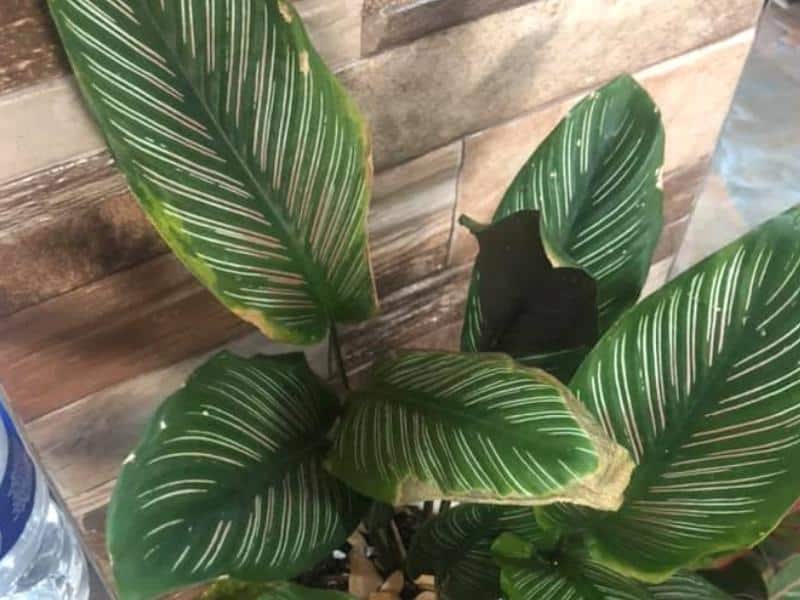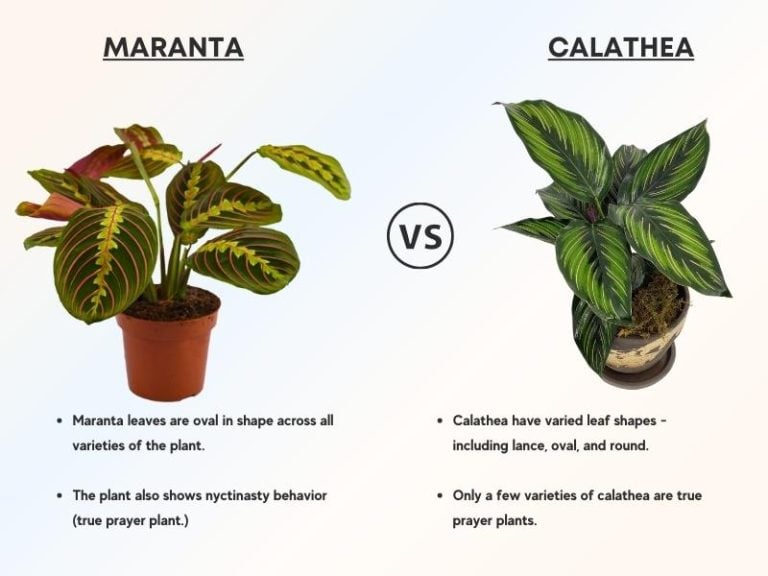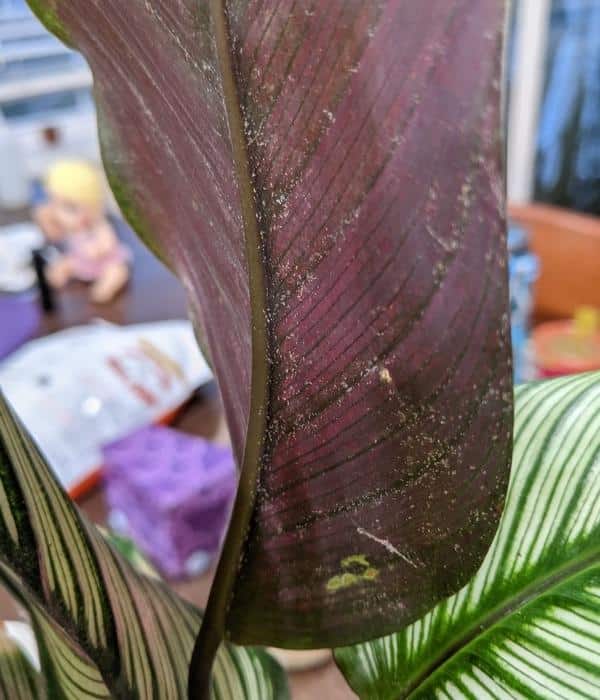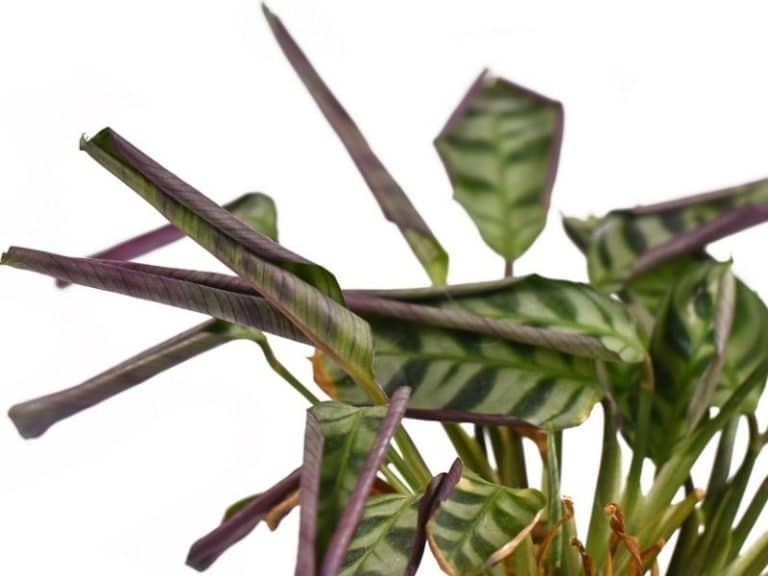Calathea Brown Edges and Tips – Causes and Fixes
Brown edges and tips in your calathea can signify that your plant has water and humidity issues. However, water issues may not be the only reason why your plant is turning brown, so, it’s important to determine the problem in order to apply the right fix.
Brown edges and tips on calathea leaves are caused by watering using hard water. Calatheas are highly sensitive to the minerals and salts found in tap water. The accumulation of chlorides and fluorides in the pot pulls water from calathea, creating a drought-like condition that causes brown tips and edges. You will also notice a ring of white deposits on the soil line.
Salty water also increases calathea’s susceptibility to insects and diseases. Coupled with humidity below 60%, calathea edges and tips turn brown. You should correct salt accumulation by giving the plant a thorough soak until water comes out of the drainage holes. Use rainwater or distilled water this time, and regularly mist the leaves.
Why are my calathea leaves turning brown?

Browning leaves can result from one or a combination of several factors. In their native home in South America, calathea thrive as undergrowth, which means they’re protected from excess light. In addition, the prevailing humidity and rainwater enhance their growth and beauty.
Here are some of the reasons your calathea leaves are turning brown:
Over-fertilizing
Excess fertilizer has the same impact as poor water quality. Fertilizers have varying degrees of phosphates, sulfates, and carbonates that will accumulate on the soil if there’s no proper drainage. Over-fertilizing causes fertilizer burn, whereby accumulated salts in the potting soil cause calathea to have brown edges and tips.
Although calatheas do not need frequent fertilizer, knowing the correct amount of fertilizer and the nitrogen, phosphorus, and potassium ratio are critical for healthy foliage. I will explain more later on how to fix over-fertilizing.
Low humidity
Low humidity is the leading cause of brown edges in calathea. Since they are native to the South American tropics, calathea can only thrive in areas with humidity above 60%. Dry air contains little moisture to keep calathea healthy.
In low moisture conditions, calathea will droop and wilt as its cells desiccate. The leaves will eventually die at the leaf margins.
Although increasing humidity indoors can be a challenge, improving moisture conditions in your home can help revive the brown edges and tips for most varieties of calathea.
Water quality
Although most people use tap water to care for calathea, no botanist would recommend it. While some people may see success with their watering, tap water from other places like Perth and the United Arab Emirates contains many salts and minerals. Dissolved salts such as chlorides and fluorides cause significant damage to calathea.
Therefore, water quality is key to the long-term survival of calathea. If your calathea edges and tips turn brown due to saline water, you may also notice a ring of white deposits in the pot and around the drainage holes. The accumulation of salt in the potting soil creates osmotic pressure, pulling water from the plant causing the leaves to turn brown.
Overwatering and underwatering
Overwatering and underwatering calathea can significantly damage your plant. Early signs of damage are yellow or brown and crispy calathea edges and tips. Overwatering is arguably the leading cause of death to houseplants because waterlogging cuts off oxygen from the soil and drowns calathea roots.
You’ll know your plant is overwatered when the soil is constantly wet to the touch. Calathea leaves start to turn yellow, and you may also notice soft, squishy stems. On the other hand, underwatering causes drought-like conditions.
Temperature stress
Temperature extremes can also have a significant impact on tropical plants like calathea. Cold drafts and heat stress interfere with the plant’s biological processes. For example, heat stress encourages transpiration and evaporation, drying up the soil and scorching the plant, and forcing calathea leaves to droop. Eventually, the prayer plant’s leaves will develop brown edges and tips.
Exposure to direct sunlight
Direct sunlight fades away the beautiful colors on calathea leaves. Additionally, direct sunlight raises soil and air temperature. Light beyond 1000 lux can cause significant damage to calathea leaves, making them turn brown starting from the edges and tips..
How to Fix Brown Edges and Tips on Calathea
Whereas some types of calathea are easy to care for, some can be very demanding. You can fix brown edges and tips on calathea by yourself, or you can seek professional assistance from botanists near you.
Here are some tips to fix brown edges and tips on calathea:
1. Fertilize the plant once a month
Having a plan for fertilizing your houseplants is crucial for their health. You can easily forget the last time you fertilized your calathea. Forgetting means condemning the plants to over-fertilizing or under-fertilizing. Use a 10-10-10 balanced houseplant fertilizer to keep your calathea healthy.
Generally, a good calathea fertilizing schedule is once every four weeks. In other words, once a month. Most importantly, fertilize calathea during spring and summer. I always recommend setting a reminder on your mobile device not to forget when to fertilize calathea. Scheduled fertilizing is essential for doing away with brown edges and tips.
2. Raise the humidity to 60%-80%
Calatheas thrive as undergrowth in 60% to 80% humidity. There are two important ways to bring indoor humidity to these recommended levels. First, you can use a plant humidifier to improve the moisture in the room. Humidifiers release water into a dry room, raising the moisture content in the airand benefiting you and the plant.
Alternatively, you can place your calathea in a pebble tray filled with water. Pebble trays are also known as humidity trays. The pebbles act as the base for the plant to sit. As the water evaporates from the tray, it creates a moisture bubble around the calathea. Like misting the leaves, pebble trays are essential for discouraging calathea brown edges and tips.
3. Flush out excess salts and irrigate with soft water
We have seen how sensitive calathea is to saline water. In the wild, calathea grow best with rainwater. Unlike hard tap water, rainwater is soft. In other words, the salt concentration in rainwater is too low to cause brown edges and tips in calathea. If you cannot find rainwater, you can use distilled or purified water for your calathea.
If your calathea turns color due to salty water, you will notice white ash-like deposits around the soil line and the drainage holes. To get rid of the excess salts, you should irrigate calathea with plenty of soft water until water flows from the drainage holes. If mineral accumulation is extreme, flush out the excess salts and re-pot your plant. Water your calathea once a week.
Without a proper watering schedule, you are likely to overwater or underwater calathea. Even with a good watering plan, your calathea edges and tips can turn brown if you go for a long holiday and lock your home. There are tips to keep the beautiful calathea leaves hydrated and healthy until you return home from a holiday.
First, water calathea at least once a week or when the top two inches of the soil feel dry. Similarly, water calathea less frequently in winter than in summer. Scheduled watering should take into account your holidays. For instance, if you travel away from home, you can keep your houseplants hydrated by bottom-watering.
That is, place all your houseplants together in a tray of water. Not only will the many calathea foliages enhance humidity, but water will also be available to the plants when you are away. Scheduled watering is essential for keeping calathea foliage healthy and vibrant. It will eliminate brown edges and tips from your houseplants.
4. Maintain a temperature range between 65°F and 85°F
Calathea performs exceptionally well between 65°F and 85°F as these temperatures resemble their native tropical habitat.
The effect of temperature on calathea is also influenced by exposure to light. Although the plant needs bright light, the light should not reach the plant directly. Instead, filter out excess light. If the temperatures are high, root elongation reduces, the plant stunts, leaf color fades, and eventually dries up.
Also, avoid placing calathea in areas receiving temperatures below 60°F.
Are browning leaves a sign the prayer plant is dying?
Browning leaves do not necessarily imply that your prayer plant is dying. Several reversible things can result in the browning of prayer plant leaves. For example, pests like spider mites on calathea have also been associated with the browning of the plant’s leaves. You may have the correct humidity, temperature, water, and light requirements and still see brown edges and tips.
However, browning leaves are a sign that your prayer plant requires attention. It is a sign of an imbalance in calatheas’ growth parameters. Identifying and fixing the problem is not a complex procedure.
Use humidifiers and pebble trays to fix browning calathea leaves. But when the leaves have fully turned brown and crispy, prune the plant to remain with green foliage or allow new leaves to emerge.
Should I cut off Brown calathea leaves?
It is advisable to cut off brown calathea leaves, so the plant focuses its strength on growing new foliage. However, do not trim more than ⅓ of the calathea’s leaves at once. Cut off calathea leaves that are infested with pests if they’re beyond saving. Pests such as spider mites can move from one leaf to another and stay on your plants for a long time.
If you notice mealybugs in your prayer plant, use a sharp scissor or a pruning shear to cut off the leaves. You may also want to replace your indoor calathea if pests largely infest it or if it turns brown beyond recovery. Once calathea leaves turn crispy, the lost edges and tips can be difficult to recover.
Brown calathea leaves can be caused by low humidity, over-fertilizing, irrigating with saline water, and overwatering and underwatering. You should cut off leaves with large crisp surfaces. Instead of the plant trying to revive the dead foliage, it will have enough strength and vigor to generate new leaves.
READ NEXT:
MARANTA VS CALATHEA: WHAT’S THE DIFFERENCE?
References
- Penn State Extension. (2016). Preventing, Diagnosing, and Correcting Common Houseplant Problems.
- The UF/IFAS Mid-Florida Research and Education Center (MREC). Calathea Production Guide.




